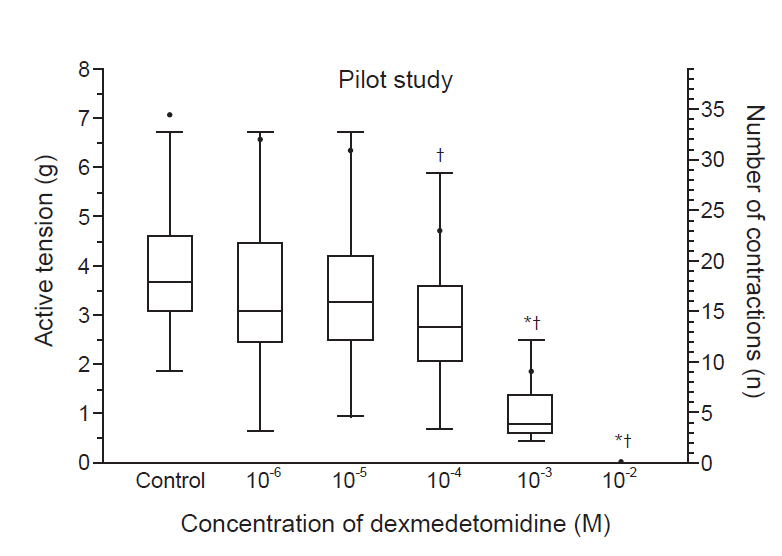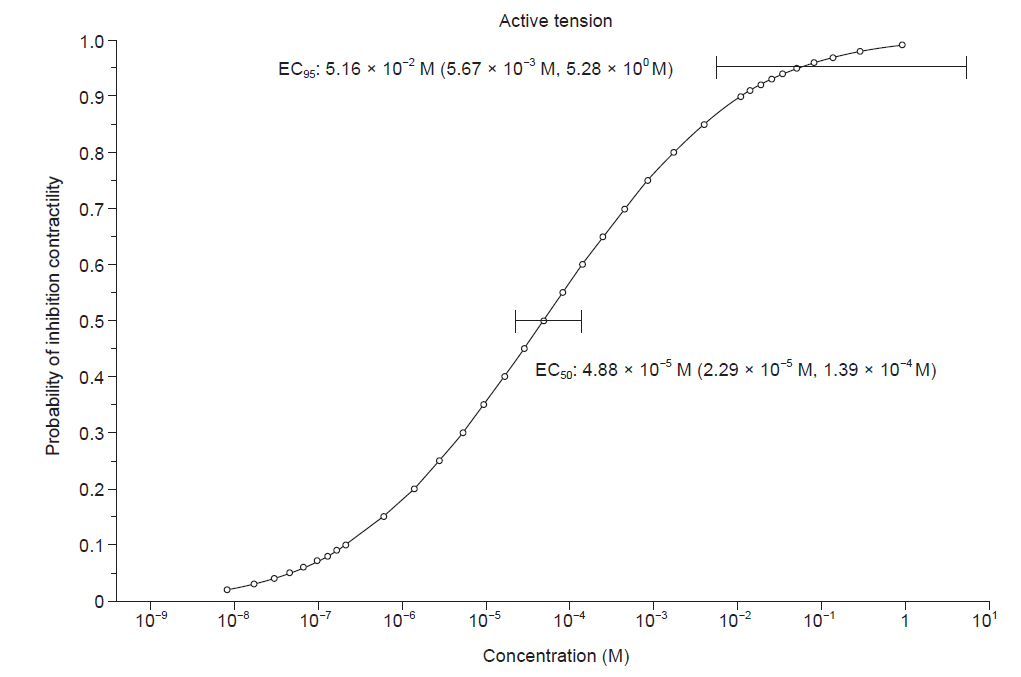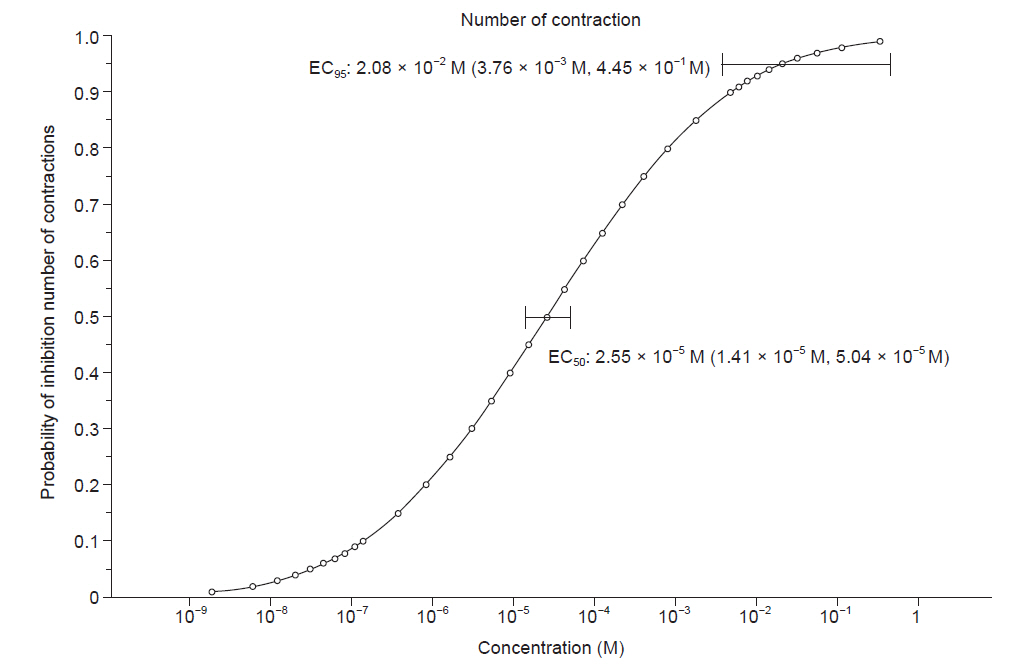Anesth Pain Med.
2020 Oct;15(4):451-458. 10.17085/apm.20036.
Clinically relevant concentrations of dexmedetomidine may reduce oxytocin-induced myometrium contractions in pregnant rats
- Affiliations
-
- 1Department of Anesthesiology and Pain Medicine, College of Medicine, Chosun University, Gwangju, Korea
- 2Department of Anesthesiology and Pain Medicine, Chosun University Hospital, Gwangju, Korea
- 3Department of Medicine, Graduate School, Chosun University, Gwangju, Korea
- KMID: 2508407
- DOI: http://doi.org/10.17085/apm.20036
Abstract
- Background
Recently, there have been some trials to use dexmedetomidine in the obstetric field but concerns regarding the drug include changes in uterine contractions after labor. We aimed to evaluate the effects of dexmedetomidine on the myometrial contractions of pregnant rats.
Methods
In a pilot study, the contraction of the myometrial strips of pregnant Sprague-Dawley rats in an organ bath with oxytocin at 1 mU/ml was assessed by adding dexmedetomidine from 10-6 to 10-2 M accumulatively every 20 min, and active tension and the number of contractions were evaluated. Then, changes in myometrial contractions were evaluated from high doses of dexmedetomidine (1.0 × 10−4 to 1.2 × 10−3 M). The effective concentrations (EC) for changes in uterine contractions were calculated using a probit model.
Results
Active tension and the number of contractions were significantly decreased at 10-3 M and 10-4 M dexmedetomidine, respectively (P < 0.05). A complete loss of contractions was seen at 10-2 M. Dexmedetomidine (1.0 × 10−4 to 1.2 × 10−3 M) decreased active tension and the number of contractions in a concentration-dependent manner. The EC95 of dexmedetomidine for inhibiting active tension and the number of contractions was 5.16 × 10-2 M and 2.55 × 10-5 M, respectively.
Conclusions
Active tension of the myometrium showed a significant decrease at concentrations of dexmedetomidine higher than 10-3 M. Thus, clinical concentrations of dexmedetomidine may inhibit uterine contractions. Further research is needed for the safe use of dexmedetomidine in the obstetrics field.
Keyword
Figure
Reference
-
1. Lee S. Dexmedetomidine: present and future directions. Korean J Anesthesiol. 2019; 72:323–30.2. Nair AS, Sriprakash K. Dexmedetomidine in pregnancy: review of literature and possible use. J Obstet Anaesth Crit Care. 2013; 3:3–6.3. Mendoza Villa JM. Dexmedetomidine as adjunct for analgesia in labor: a report of two cases. Rev Colomb Anestesiol. 2012; 40:79–81.4. El-Arab NKE, El-Hawary SI, El-Zeftawy AE, Mohammed RM. Dexmedetomidine in preeclamptic patients undergoing caesarean section under general anesthesia. Tanta Med J. 2017; 45:220–5.5. Mishra N, Jain A, Sharma M. Intravenous dexmedetomidine for labour analgesia in women with preeclampsia. J Evol Med Dent Sci. 2016; 5:3408–11.6. Wang J, Han Z, Zhou H, Wang N, Ma H. Effective loading dose of dexmedetomidine to induce adequate sedation in parturients undergoing caesarean section under spinal anaesthesia. Turk J Anaesthesiol Reanim. 2017; 45:260–3.7. Karaman S, Evren V, Firat V, Cankayali I. The effects of dexmedetomidine on spontaneous contractions of isolated gravid rat myometrium. Adv Ther. 2006; 23:238–43.8. Sia AT, Kwek K, Yeo GS. The in vitro effects of clonidine and dexmedetomidine on human myometrium. Int J Obstet Anesth. 2005; 14:104–7.9. Öcal I, Güneş Y, Mert T, Özcengiz D, Günay I. Dexmedetomidine modifies uterine contractions in pregnancy terms of rats. Indian J Pharmacol. 2013; 45:168–73.10. Weerink MAS, Struys MMRF, Hannivoort LN, Barends CRM, Absalom AR, Colin P. Clinical pharmacokinetics and pharmacodynamics of dexmedetomidine. Clin Pharmacokinet. 2017; 56:893–913.11. Kim M. Study on adrenoceptors of the rat uterus. Hanyang J Med. 1982; 2:383–93.12. Kilkenny C, Browne W, Cuthill IC, Emerson M, Altman DG; National Centre for the Replacement, Refinement and Reduction of Amimals in Research. Animal research: reporting in vivo experiments--the ARRIVE guidelines. J Cereb Blood Flow Metab. 2011; 31:991–3.13. Agoston DV. How to translate time? The temporal aspect of human and rodent biology. Front Neurol. 2017; 8:92.14. Chung CD, An TH, Jung KT, Lee TH. The effects of etomidate on the contraction of pregnant rat uterine smooth muscle. Korean J Anesthesiol. 2009; 57:84–7.15. Lee S, Hwang GB, Baik CY. The relationship of the estimates of effective concentration calculated by logit, probit, and sigmoid Emax. Korean J Anesthesiol. 2002; 43:345–7.16. Drew GM, Whiting SB. Evidence for two distinct types of postsynaptic alpha-adrenoceptor in vascular smooth muscle in vivo. Br J Pharmacol. 1979; 67:207–15.17. Gertler R, Brown HC, Mitchell DH, Silvius EN. Dexmedetomidine: a novel sedative-analgesic agent. Proc (Bayl Univ Med Cent). 2001; 14:13–21.18. Kitazawa T, Maezono Y, Taneike T. The mechanisms of alpha(2)-adrenoceptor agonist-induced contraction in longitudinal muscle of the porcine uterus. Eur J Pharmacol. 2000; 390:185–95.19. Berg G, Andersson RG, Ryden G. Alpha-adrenergic receptors in human myometrium during pregnancy. Am J Obstet Gynecol. 1986; 154:601–6.20. Arrowsmith S, Wray S. Oxytocin: its mechanism of action and receptor signalling in the myometrium. J Neuroendocrinol. 2014; 26:356–69.21. Kim DJ, Hwang MH, An TH, Jung KT. The relaxant effect of nicardipine on the isolated uterine smooth muscle of the pregnant rat. Anesth Pain Med. 2019; 14:429–33.22. Kyozuka M, Crankshaw DJ, Crankshaw J, Berezin I, Kwan CY, Daniel EE. Alpha-2 adrenoceptors on nerves and muscles of rat uterus. J Pharmacol Exp Ther. 1988; 244:1128–38.23. Fairbanks CA, Stone LS, Wilcox GL. Pharmacological profiles of alpha 2 adrenergic receptor agonists identified using genetically altered mice and isobolographic analysis. Pharmacol Ther. 2009; 123:224–38.24. Gáspár R, Gál A, Gálik M, Ducza E, Minorics R, Kolarovszki-Sipiczki Z, et al. Different roles of alpha2-adrenoceptor subtypes in non-pregnant and late-pregnant uterine contractility in vitro in the rat. Neurochem Int. 2007; 51:311–8.25. Hajagos-Tóth J, Bóta J, Ducza E, Samavati R, Borsodi A, Benyhe S, et al. The effects of progesterone on the alpha2-adrenergic receptor subtypes in late-pregnant uterine contractions in vitro. Reprod Biol Endocrinol. 2016; 14:33.
- Full Text Links
- Actions
-
Cited
- CITED
-
- Close
- Share
- Similar articles
-
- The effects of etomidate on the contraction of pregnant rat uterine smooth muscle
- The Effects of Nitroglycerin on the Contraction of Rat Uterine Smooth Muscle
- Role of T-type Ca2+ Channels in the Spontaneous Phasic Contraction of Pregnant Rat Uterine Smooth Muscle
- Dexmedetomidine does not produce vasocontraction on human isolated gastroepiploic artery
- Oxytocin and Oxytocin Antagonist Metabolism in the Plasma of Pregnant Women




